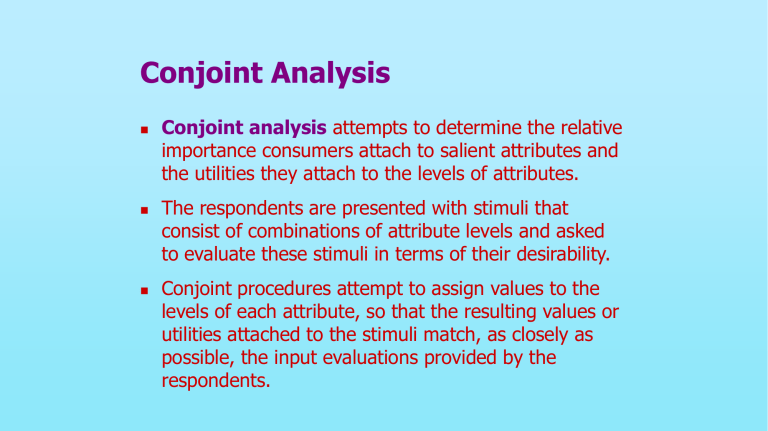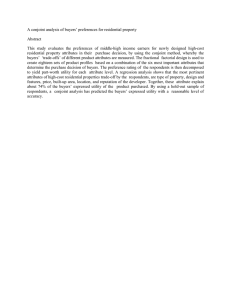
Conjoint Analysis ◼ ◼ ◼ Conjoint analysis attempts to determine the relative importance consumers attach to salient attributes and the utilities they attach to the levels of attributes. The respondents are presented with stimuli that consist of combinations of attribute levels and asked to evaluate these stimuli in terms of their desirability. Conjoint procedures attempt to assign values to the levels of each attribute, so that the resulting values or utilities attached to the stimuli match, as closely as possible, the input evaluations provided by the respondents. What is Conjoint Analysis? ◼ ◼ ◼ ◼ Research technique developed in early 70s Measures how buyers value components of a product/service bundle Dictionary definition-- “Conjoint: Joined together, combined.” Marketer’s catch-phrase-- “Features CONsidered JOINTly” How Does Conjoint Analysis Work? ◼ ◼ ◼ ◼ We vary the product/service features (independent variables) to build many (usually 12 or more) product concepts We ask respondents to rate/rank or choose among a subset of those product concepts (dependent variable) Based on the respondents’ evaluations of the product concepts, we figure out how much unique value (utility) each of the features (attributes) added (Regress dependent variable on independent variables; estimated betas equal to part worth utilities.) Traditional, Less-Effective Questions ◼ How important is horsepower to you in a vehicle? ◼ How important is fuel efficiency to you in a vehicle? ◼ Which is more important to you, horsepower or fuel efficiency? What’s So Good about Conjoint? ◼ More realistic questions: Which product would you prefer . . . - 210 horsepower or - 140 horsepower - 17 MPG ◼ ◼ - 28 MPG If choose left, you prefer Power. If you choose right, you prefer Fuel Economy Rather than ask directly whether you prefer Power over Fuel Economy, we present realistic tradeoff scenarios and infer preferences from your product choices What’s So Good about Conjoint? (cont.) ◼ ◼ When respondents are forced to make difficult tradeoffs, we learn what they truly value These values (utility scores) are associated with specific and actionable attribute levels relevant to the problem at hand Building a Model ◼ Inputs: ◼ Attributes ◼ Levels ◼ Respondents ◼ Prior Knowledge ◼ External Data ◼ Experimental Design ◼ Conjoint Method ◼ Outputs: ◼ ◼ ◼ Utility Scores for each level Importance Scores for each attribute Ability to perform Simulations Defining Attributes ◼ ◼ ◼ ◼ ◼ Attributes are independent aspects of a product or a service (Brand, Price, Size, Color etc.) How many attributes? -Depends on research objectives ◼ One rule of thumb was that no more than 6 0r 7 attributes is too much ◼ May cause respondents to simplify, looking only at 2-3 most important Attributes should be independent, mutually exclusive ◼ Brand, quality and product life expectancy may all measure the same thing Each attribute has varying degrees, or “levels” ◼ Cost: $1, $2, $3 ◼ ◼ Biodiversity Loss: 10, 50, 100 Each level is assumed to be mutually exclusive of the others (a program has one and only one level of that attribute) Rules for Formulating Attribute Levels ◼ Attributes are assumed to be mutually exclusive ◼ ◼ ◼ ◼ ◼ Attribute: Add-on features Level 1= Sun roof Level 2= GPS system Level 3=DVD player If you define levels in this way, you cannot determine the value of providing 2 or 3 of these features at the same time (or none of them) Solutions ◼ ◼ 8 level Attribute: Features ◼ ◼ ◼ ◼ ◼ ◼ ◼ ◼ None Sunroof GPS system DVD Player Sunroof, GPS Sunroof, DVD GPS, DVD Sunroof, GPS, DVD ◼ 3 Binary Attributes: ◼ Sunroof: ◼ ◼ ◼ GPS System ◼ ◼ ◼ None Sunroof None GPS DVD Player ◼ ◼ None DVD Player Rules for Formulating Attribute Levels ◼ ◼ ◼ ◼ Levels should have concrete/unambiguous meaning “very expensive” vs “ costs $575” “weight: 5-7 kilos” vs “ weight 6 kilos” -One description leaves meaning up to individual interpretation, while the other does not Rules for Formulating Attribute Levels ◼ Don’t include too many levels for any one attribute ◼ ◼ The usual number is about 3-5 levels per attribute Make sure levels from your attributes can combine freely with one another without resulting in utterly impossible combinations (very unlikely combinations OK) Statistics and Terms Associated with Conjoint Analysis ◼ ◼ ◼ ◼ ◼ Part-worth functions. The part-worth functions, or utility functions, describe the utility consumers attach to the levels of each attribute. Relative importance weights. The relative importance weights are estimated and indicate which attributes are important in influencing consumer choice. Attribute levels. The attribute levels denote the values assumed by the attributes. Full profiles. Full profiles, or complete profiles of brands, are constructed in terms of all the attributes by using the attribute levels specified by the design. Pairwise tables. In pairwise tables, the respondents evaluate two attributes at a time until all the required pairs of attributes have been evaluated. Statistics and Terms Associated with Conjoint Analysis ◼ ◼ ◼ ◼ Cyclical designs. Cyclical designs are designs employed to reduce the number of paired comparisons. Fractional factorial designs. Fractional factorial designs are designs employed to reduce the number of stimulus profiles to be evaluated in the full profile approach. Orthogonal arrays. Orthogonal arrays are a special class of fractional designs that enable the efficient estimation of all main effects. Internal validity. This involves correlations of the predicted evaluations for the holdout or validation stimuli with those obtained from the respondents. Conducting Conjoint Analysis Formulate the Problem Construct the Stimuli Decide the Form of Input Data Select a Conjoint Analysis Procedure Interpret the Results Assess Reliability and Validity Conducting Conjoint Analysis Formulate the Problem ◼ ◼ ◼ ◼ ◼ Identify the attributes and attribute levels to be used in constructing the stimuli. The attributes selected should be salient in influencing consumer preference and choice and should be actionable. A typical conjoint analysis study involves six or seven attributes. At least three levels should be used, unless the attribute naturally occurs in binary form (two levels). The researcher should take into account the attribute levels prevalent in the marketplace and the objectives of the study. Conducting Conjoint Analysis Construct the Stimuli ◼ ◼ ◼ In the pairwise approach, also called two-factor evaluations, the respondents evaluate two attributes at a time until all the possible pairs of attributes have been evaluated. In the full-profile approach, also called multiple-factor evaluations, full or complete profiles of brands are constructed for all the attributes. Typically, each profile is described on a separate index card. In the pairwise approach, it is possible to reduce the number of paired comparisons by using cyclical designs. Likewise, in the full-profile approach, the number of stimulus profiles can be greatly reduced by means of fractional factorial designs. Sneaker Attributes and Levels Attribute Number Level Description Sole 3 2 1 Rubber Polyurethane Plastic Upper 3 2 1 Leather Canvas Nylon Price 3 2 1 $30.00 $60.00 $90.00 Full-Profile Approach to Collecting Conjoint Data Example of a Sneaker Product Profile Sole Made of rubber Upper Made of nylon Price $30.00 Pairwise Approach to Conjoint Data Sole Rubber U p p e r Sole Polyurethane Rubber Plastic P r i c e Leather Canvas $30.00 $60.00 $90.00 Nylon Price $ 30.00 Leather U p p e r Canvas Nylon $60.00 $90.00 Polyurethane Plastic Conducting Conjoint Analysis Construct the Stimuli ◼ ◼ A special class of fractional designs, called orthogonal arrays, allow for the efficient estimation of all main effects. Orthogonal arrays permit the measurement of all main effects of interest on an uncorrelated basis. These designs assume that all interactions are negligible. Generally, two sets of data are obtained. One, the estimation set, is used to calculate the part-worth functions for the attribute levels. The other, the holdout set, is used to assess reliability and validity. Conducting Conjoint Analysis Decide on the Form of Input Data ◼ ◼ ◼ ◼ ◼ For non-metric data, the respondents are typically required to provide rank-order evaluations. In the metric form, the respondents provide ratings, rather than rankings. In this case, the judgments are typically made independently. In recent years, the use of ratings has become increasingly common. The dependent variable is usually preference or intention to buy. However, the conjoint methodology is flexible and can accommodate a range of other dependent variables, including actual purchase or choice. In evaluating sneaker profiles, respondents were required to provide preference. Sneaker Profiles and Ratings Attribute Levels Profile No. 1 2 3 4 5 6 7 8 9 Sole 1 1 1 2 2 2 3 3 3 a Upper Price 1 1 2 2 3 3 1 2 2 3 3 1 1 3 2 1 3 2 Preference Rating 9 7 5 6 5 6 5 7 6 Conducting Conjoint Analysis Decide on the Form of Input Data The basic conjoint analysis model may be represented by the following formula: m U(X ) = i =1 ki a x j =1 ij ij Where: U(X) a ij xjj ki m = overall utility of an alternative = the part-worth contribution or utility associated with the j th level (j, j = 1, 2, . . . ki) of the i th attribute (i, i = 1, 2, . . . m) = 1 if the j th level of the i th attribute is present = 0 otherwise = number of levels of attribute i = number of attributes Conducting Conjoint Analysis Decide on the Form of Input Data The importance of an attribute, Ii, is defined in terms of the range of the part-worths, a ij, across the levels of that attribute: The attribute's importance is normalized to ascertain its importance relative to other attributes, Wi: Wi = I I i m i =1 i m So that W i = 1 i =1 The simplest estimation procedure, and one which is gaining in popularity, is dummy variable regression (see Chapter 17). If an attribute has ki levels, it is coded in terms of ki - 1 dummy variables (see Chapter 14). Other procedures that are appropriate for non-metric data include LINMAP, MONANOVA, and the LOGIT model. Conducting Conjoint Analysis Decide on the Form of Input Data The model estimated may be represented as: U = b0 + b1X1 + b2X2 + b3X3 + b4X4 + b5X5 + b6X6 Where: X1, X2 = dummy variables representing Sole X3, X4 = dummy variables representing Upper X5, X6 = dummy variables representing Price For Sole the attribute levels were coded as follows: Level 1 Level 2 Level 3 X1 X2 1 0 0 0 1 0 Sneaker Data Coded for Dummy Variable Regression Preference Ratings Y 9 7 5 6 5 6 5 7 6 Sole X1 X2 1 1 1 0 0 0 0 0 0 0 0 0 1 1 1 0 0 0 Attributes Upper X3 X4 1 0 0 1 0 0 1 0 0 0 1 0 0 1 0 0 1 0 Price X5 X6 1 0 0 0 0 1 0 1 0 0 1 0 1 0 0 0 0 1 Conducting Conjoint Analysis Decide on the Form of Input Data The levels of the other attributes were coded similarly. The parameters were estimated as follows: b0 b1 b2 b3 b4 b5 b6 = 4.222 = 1.000 = -0.333 = 1.000 = 0.667 = 2.333 = 1.333 Given the dummy variable coding, in which level 3 is the base level, the coefficients may be related to the part-worths: a11 - a13 = b1 a12 - a13 = b2 Conducting Conjoint Analysis Decide on the Form of Input Data To solve for the part-worths, an additional constraint is necessary. a11 + a12 + a13 = 0 These equations for the first attribute, Sole, are: a 11 - a 13 = 1.000 a 12 - a 13 = -0.333 a11 + a12 + a13 = 0 Solving these equations, we get: a11 a12 a13 = 0.778 = -0.556 = -0.222 Conducting Conjoint Analysis Decide on the Form of Input Data The part-worths for other attributes reported in Table 21.6 can be estimated similarly. For Upper we have: a 21 - a 23 = b3 a 22 - a 23 = b4 a21 + a22 + a23 = 0 For the third attribute, Price, we have: a 31 - a 33 = b5 a 32 - a 33 = b6 a31 + a32 + a33 = 0 Conducting Conjoint Analysis Decide on the Form of Input Data The relative importance weights were calculated based on ranges of part-worths, as follows: Sum of ranges of part-worths = (0.778 - (-0.556)) + (0.445-(-0.556)) + (1.111-(-1.222)) = 4.668 Relative importance of Sole Relative importance of Upper Relative importance of Price = 1.334/4.668 = 0.286 = 1.001/4.668 = 0.214 = 2.333/4.668 = 0.500 Results of Conjoint Analysis Attribute Sole Upper Price Level No. Description Utility 3 2 1 Rubber Polyurethane Plastic 0.778 -0.556 -0.222 3 2 1 Leather Canvas Nylon 0.445 0.111 -0.556 0.214 3 2 1 $30.00 $60.00 $90.00 1.111 0.111 -1.222 0.500 Importance 0.286 Conducting Conjoint Analysis Interpret the Results ◼ ◼ ◼ For interpreting the results, it is helpful to plot the part-worth functions. The utility values have only interval scale properties, and their origin is arbitrary. The relative importance of attributes should be considered. Conducting Conjoint Analysis Assessing Reliability and Validity ◼ ◼ ◼ ◼ The goodness of fit of the estimated model should be evaluated. For example, if dummy variable regression is used, the value of R2 will indicate the extent to which the model fits the data. Test-retest reliability can be assessed by obtaining a few replicated judgments later in data collection. The evaluations for the holdout or validation stimuli can be predicted by the estimated part-worth functions. The predicted evaluations can then be correlated with those obtained from the respondents to determine internal validity. If an aggregate-level analysis has been conducted, the estimation sample can be split in several ways and conjoint analysis conducted on each subsample. The results can be compared across subsamples to assess the stability of conjoint analysis solutions. Part-Worth Functions 0.0 0.0 Utility -1.0 -1.5 -0.4 -0.8 -1.2 Leather -2.0 Rubber Polyureth. Plastic Canvas Sole Nylon 0.0 -0.5 Sole -1.0 Utility Utility -0.5 -1.5 -2.0 -2.5 -3.0 $30 $60 Price $90 Assumptions and Limitations of Conjoint Analysis ◼ ◼ ◼ ◼ ◼ Conjoint analysis assumes that the important attributes of a product can be identified. It assumes that consumers evaluate the choice alternatives in terms of these attributes and make tradeoffs. The tradeoff model may not be a good representation of the choice process. Another limitation is that data collection may be complex, particularly if a large number of attributes are involved and the model must be estimated at the individual level. The part-worth functions are not unique.

